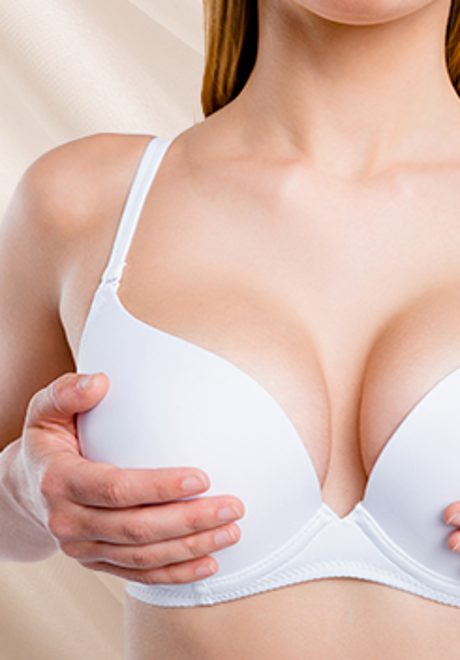Breast Reduction
Breast reduction surgery is a reconstructive procedure to solve the problems caused by big breasts such as back pain, posture disorder, shoulder pain, difficulty in breathing, the collapse of the shoulder from bra straps, and hygiene problems under the breast (such as rash or fungal infections).
Why do breasts sag?
Breast structure may change due to the effects of gravity, deformation caused by births and breastfeeding, and the loss of elasticity of tissues over the years. Formerly erect, full, alive breasts may become emptied, loosened, and sagged over time
Weight gain also contributes negatively to this process. The time spent with children at home after birth, changing habits of living, and decreasing exercise time also increase the problem of weight gain.
The breast consists of fat and a mammary gland. Weight gain increases fat tissue. Breastfeeding inflates the mammary gland and both of them enlarge the breast, causing cracks and sagging of the skin surrounding the breast.
Also with these effects, the nipple, and the surrounding brown area widen and distort the visual perception. As you gain weight, the ligaments that hang the breasts on the chest wall can no longer carry the breasts. The breast hangs towards the fold and then further below the fold. The nipple turns down, not facing forward.
What other health problems do the enlargement and sagging of breasts cause?
Breast sagging does not only lead to an unaesthetic appearance. Over time, the breasts hanging on the chest wall begin to pull the torso forward. As the breasts grow, this effect increases, and irrepressible lower back pain occurs. The bras put pressure on the shoulders, causing shoulder, neck, and arm pain. Many women have been incorrectly treated for neck hernias due to these pains. This pain becomes worse because of bone density reduction after menopause.
Redness, rashes, and fungi appear under the breast. Despondency, insecurity, and depression begin in women who cannot exercise comfortably due to sagging and big breasts and who are unable to wear the clothes they like.
Can breast sagging be treated without surgery?
There is no non-surgical method to reduce and lift the breasts after they grow and sag.
Even if the person loses weight, the ligaments carrying the breast have loosened once, the skin has sagged, and the nipple has enlarged. Losing weight at this point only causes the sagging breast to become even more emptied and wrinkled.
All these problems can only be corrected by breast reduction and breast lift operations.
How is breast reduction surgery performed?
Breast reduction and lift operations have a special place in the history of aesthetic surgery. Since the early 19th century, many surgeons have sought to address these problems of women. Hundreds of different surgical techniques have emerged. The process started with taking the breast and nipple completely, continued with freely leaving the nipple, and with the development of anatomical and surgical knowledge, the methods in which the nipple is kept alive and sensuous, the excess of the breast is taken out and then the remaining part is shaped have been reached.
Even though these modern techniques have yielded very satisfactory results, research has continued to further reduce the scars. In this way, short-scar techniques, where the breast has been both reduced and lifted and the nipple vitality, sense, and ability to breastfeed have been preserved, have been reached today.
Duration of breast reduction surgery
Breast reduction surgery usually takes 2-4 hours. Differences may occur depending on the size of the breasts and the technique chosen.
Anesthesia method
Breast reduction operations are performed under general anesthesia by aesthetic plastic surgery physicians in operating room conditions.
Surgical technique
A qualified surgeon does not work with only one technique. S/he evaluates many variables such as body and breast structure, age, expectation, the healing process, whether or not to give birth, additional diseases, and lifestyle and guides the person to choose the most appropriate technique.
It is possible to perform short-scar surgeries in cases where the breast is not very large, slightly sagging, the nipple is not entirely under the inframammary fold and the breast notch-nipple distance is not extended too much. There will be a vertical scar only between the nipple and the breast fold, which will fade over time.
However, in cases where the breast is quite plump and large and the notch-nipple distance is too high(>10 cm), very short-scar techniques are not safe. To protect the viability and sensation of the nipple, techniques that cause slightly longer scars are preferred. these scars will remain at the fold level under the breast and will be invisible at a glimpse.
For extremely large breasts, elderly people, and the ones with comorbidities, faster healing techniques will be preferred.
Which techniques give better and lasting results?
The plastic surgeon who wishes to achieve a permanent result with the procedure must meet the following conditions:
If the dark area around the nipple is enlarged, it should be reduced.
While the nipple is replaced, its sensibility and blood flow should be kept alive.
After removing excess and sagging breast tissue, the remaining breast tissue should be shaped.
During this shaping, if necessary, the breast extending towards the armpit should be reduced by using liposuction.
Create as short scars as possible.
Breast skin should be sutured by spreading conveniently on the breast tissue without creating any strain.
The breast skin should be considered only as a cover of breast tissue. In the old techniques, the breast was reduced, and the skin sutures were so tight that they were used to carry the breast. Nevertheless, breast skin is never strong enough to carry the breasts. Therefore, in old techniques, the scars expand, and the breast quickly sags again.
Today breast tissue and skin are thought to be separate structures. After the excess is removed, the remaining tissue is shaped with stitches and hung on the chest wall, then the skin is gently spread over and sutured. Thus, the result is permanent, and the scars are temporary.
Before breast reduction surgery
You should talk to your doctor in detail about how you will look after the procedure. You should give your opinion on the size of the breast you want. You should learn about your recovery process and when you can get back to work. You must have realistic expectations.
- The mutual trust between you and your doctor is the key to overcoming the problems you have experienced for aesthetic reasons.
- Mammography/breast ultrasonography should be performed before breast reduction surgery.
- Some drugs may interact with anesthesia. So, you should tell your doctor about the medications you use before surgery.
- Particularly aspirin and derivative blood thinners should be discontinued at least one week before surgery.
- Smoking hurts the healing of the suture area and scars. Therefore, leave it as early as possible before the surgery and never start again if possible.
- Inform your doctor if you feel a cold or a sore throat before the surgery.
Recovery process after breast reduction surgery
- After the procedure, you will wake up in your room with your breasts taped and a special bra worn.
- We use drains for most patients. Drains are usually removed the next day at hospital leave or within a few days, depending on the situation.
- After 3-4 hours you can start taking liquid foods. You can walk around your room.
- The first night is easily controlled with painkillers, even if there is slight pain.
- Pain relief, serum, and antibiotic treatment will be planned accordingly during the hospital stay.
- Most patients are checked again the next day, and their drains are removed and discharged (Rarely, we can keep the drains for 1-2 days for patient safety).
- When you go home, we recommend that you eat liquid food, use the recommended antibiotics and painkillers properly, and wear your bra tightly without removing it.
- In 15 days, staying away from the activities where you use your arms and not making the moves that cause you pain will accelerate your recovery.
- You can take a bath 3 days after the procedure and return to your normal life in 5-7 days.
Is there any scar after breast reduction surgery?
The scars from breast reduction surgery are initially red, then purple and pink. They will fade within 6 months to a year and become vague.
Before the procedure, scars are the main topic. Somehow, no one mentions the scar after surgery. Patients who like the newly formed breast shape and have no more problems carrying large breasts do not complain about the scar at the end. Anyway, the scars will fade and diminish in a year.
Post-operative creams and silicone gels will be prescribed to reduce scars after surgery.
Those with wound healing disorders, such as hypertrophic scar/keloid formation, should indicate their condition before the procedure so that the necessary precautions will be taken.
Any age limit for breast reduction surgery?
Breast reduction surgery can be performed from the age of 18 years. It is possible to lessen this age further in cases where the breast is too large, or the existence of various hormonal disorders is possible.
Furthermore, due to the anatomical and psychological problems that may arise due to the extremely asymmetric breasts during puberty, surgery can be performed at an earlier age.
What should be considered after breast reduction surgery?
You should rest for at least 3 days after the operation. You will use antibiotics and painkillers after surgery. You mustn't interrupt your medicines, controls, and wound dressings.
During recovery, you should avoid physical activities that force your arm for at least 4 weeks. Avoid pushing, pulling, or swimming. Wearing a sports bra for the first month will be useful in both reducing pain and shaping the breasts. Non-smoking after surgery speeds up your recovery and improves the quality of the scar.
Can I breastfeed after breast reduction?
To breastfeed, the connection between the “nipple-milk channels-mammary gland” must be intact. The techniques used in cases where the breasts are not too large, and the nipple is not excessively sagging do not disrupt this relationship. The larger the breasts and the longer the distance that the nipple will be lifted, the greater the risk of breastfeeding ability.
I strive to use techniques that maintain breastfeeding function in every breast surgery. Nonetheless, there is a small possibility for loss of breastfeeding function after breast reduction surgery. Because in each breast reduction surgery, a certain amount of breast tissue must be removed (this is compulsory for breast reduction).
Breast Plastic Surgery Types
There are different types of breast aesthetics that can be applied depending on the type of problem experienced.



